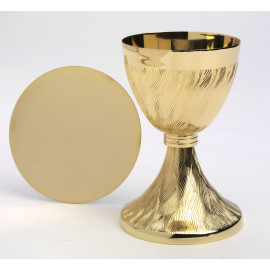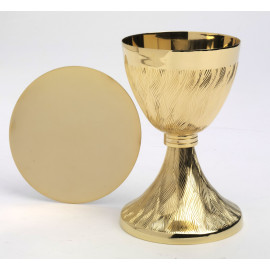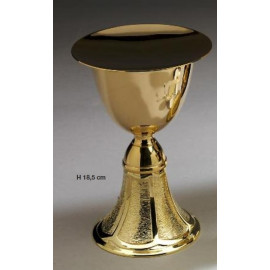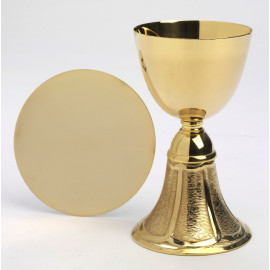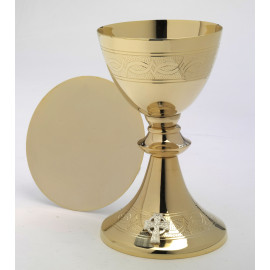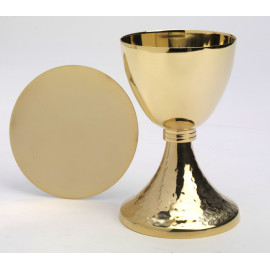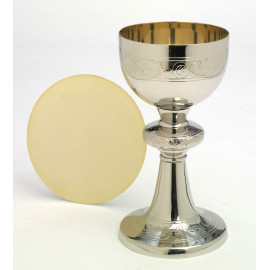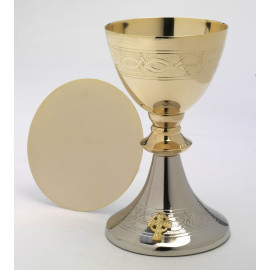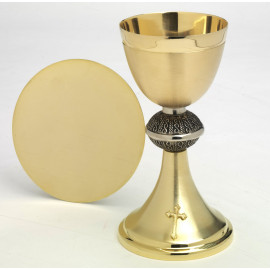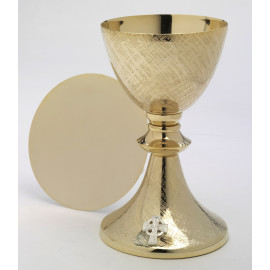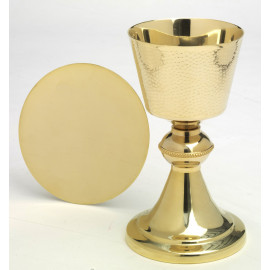No products
Product successfully added to your shopping cart
There are 0 items in your cart. There is 1 item in your cart.
Chalices
- Altar Bell and Gong
- Candle Snuffer
- Candlestick
- Catholic Pyx
- Chalices
- Church wall lamps
- Ciborium
- Crosses and Crucifix
- Cruets & Trays
- Holy Water Font
- Holy Water Pot
- Missal Stand
- Monstrance Tabor
- Monstrances
- Offering Baskets
- Oil Stock
- Patens
- Reliquaries
- Sanctuary Bells
- Sanctuary Lamp
- Sprinkler
- Thurible, Boat, & Spoon
- Travel Liturgy & Mass Kit
A liturgical chalice is a cup used in the celebration of the Christian Eucharist, which holds the sacramental wine during the Mass. It is considered one of the most sacred vessels in Christian liturgical worship and is often blessed before use. The chalice is made of durable material and comes in various shapes and sizes. Liturgical rules impose that at least the inside of the chalice cup is made of a precious metal, gold or silver, or at least gilt on the inside because it is destined to touch Christ’s Blood or Body. It is forbidden to use a non-noble metal for the cup, which may generate rust that causes nausea. The chalice is one of the necessary items for the celebration of the Eucharistic Supper (Holy Mass).
A liturgical chalice is a cup used in the celebration of the Christian Eucharist, which holds the sacramental wine during the Mass. It is considered one of the most sacred vessels in Christian liturgical worship and is often blessed before use. The chalice is made of durable material and comes in various shapes and sizes. Liturgical rules impose that at least the inside of the chalice cup is made of a precious metal, gold or silver, or at least gilt on the inside because it is destined to touch Christ’s Blood or Body. It is forbidden to use a non-noble metal for the cup, which may generate rust that causes nausea. The chalice is one of the necessary items for the celebration of the Eucharistic Supper (Holy Mass).
Chalices There are 51 products.
The Liturgical Chalice: A Vessel of Sacred Tradition
The liturgical chalice stands as a central symbol in Christian worship, particularly within the context of the Eucharist or Holy Communion. This sacred vessel, steeped in religious tradition and history, serves as more than just a container for sacramental wine; it is a profound emblem of faith, representing the blood of Christ shed for humanity.
Historical Significance and Evolution
Tracing its roots back to the Last Supper, the liturgical chalice has evolved from a simple cup to an ornate object of veneration. In the early Christian church, chalices were likely made from wood or glass, but as Christianity grew and became more established, precious metals such as gold and silver became the materials of choice. This transition not only reflected the importance of the Eucharist but also the church's increasing wealth and influence. The design of the chalice has also undergone significant changes over the centuries. Early examples often featured a large bowl with two handles, but as time progressed, the bowl became smaller, and the base expanded for greater stability. The addition of a node, or pommel, where the stem meets the cup, made the elevation of the chalice easier during liturgical ceremonies.
Symbolism and Artistry
The artistry of the liturgical chalice is rich with symbolism. Many chalices are adorned with religious iconography, such as the crucifix, saints, or scenes from the Bible, each element meticulously crafted to inspire reverence and contemplation. The use of jewels and enamels adds to the visual splendor and signifies the preciousness of the sacrament contained within.
Modern-Day Usage and Variations
In contemporary worship, the liturgical chalice continues to be a focal point of the Eucharistic celebration. While some denominations may opt for simpler designs, the chalice remains a vessel of honor, often consecrated before use and treated with the utmost respect. The choice of materials and design can vary widely, reflecting the diversity of Christian traditions and theologies.
FAQs About the Liturgical Chalice
What is a liturgical chalice made of?
Traditionally, a liturgical chalice is made from precious metals like gold or silver, often gold-plated on the inside to honor the sanctity of the Eucharist. However, modern chalices can also be made from other durable and worthy materials approved by ecclesiastical authorities.
Why is the chalice important in Christian worship?
The chalice is important because it holds the wine that, during the Eucharist, becomes the blood of Christ. It is a symbol of Christ's sacrifice and a central element of the liturgy, reminding the faithful of the covenant between God and humanity.
Can any cup serve as a liturgical chalice?
While any cup could theoretically serve as a chalice, the church typically requires that a liturgical chalice be consecrated and reserved for sacred use. This ensures the dignity and reverence due to the sacrament of the Eucharist.
How is a liturgical chalice consecrated?
A liturgical chalice is consecrated through a blessing by a bishop or a priest with the authority to do so. The consecration sets the chalice apart for holy use and is often accompanied by anointing with chrism, a sacred oil.
Are there different styles of chalices?
Yes, there are various styles of chalices, ranging from the highly ornate to the very simple. The style often reflects the liturgical traditions and aesthetic preferences of a particular church or denomination.
In conclusion, the liturgical chalice is a vessel that carries deep historical roots, rich symbolism, and profound significance within Christian worship. Its presence on the altar during the Eucharist serves as a tangible connection to the divine, a tradition that continues to be cherished and upheld in churches around the world.

